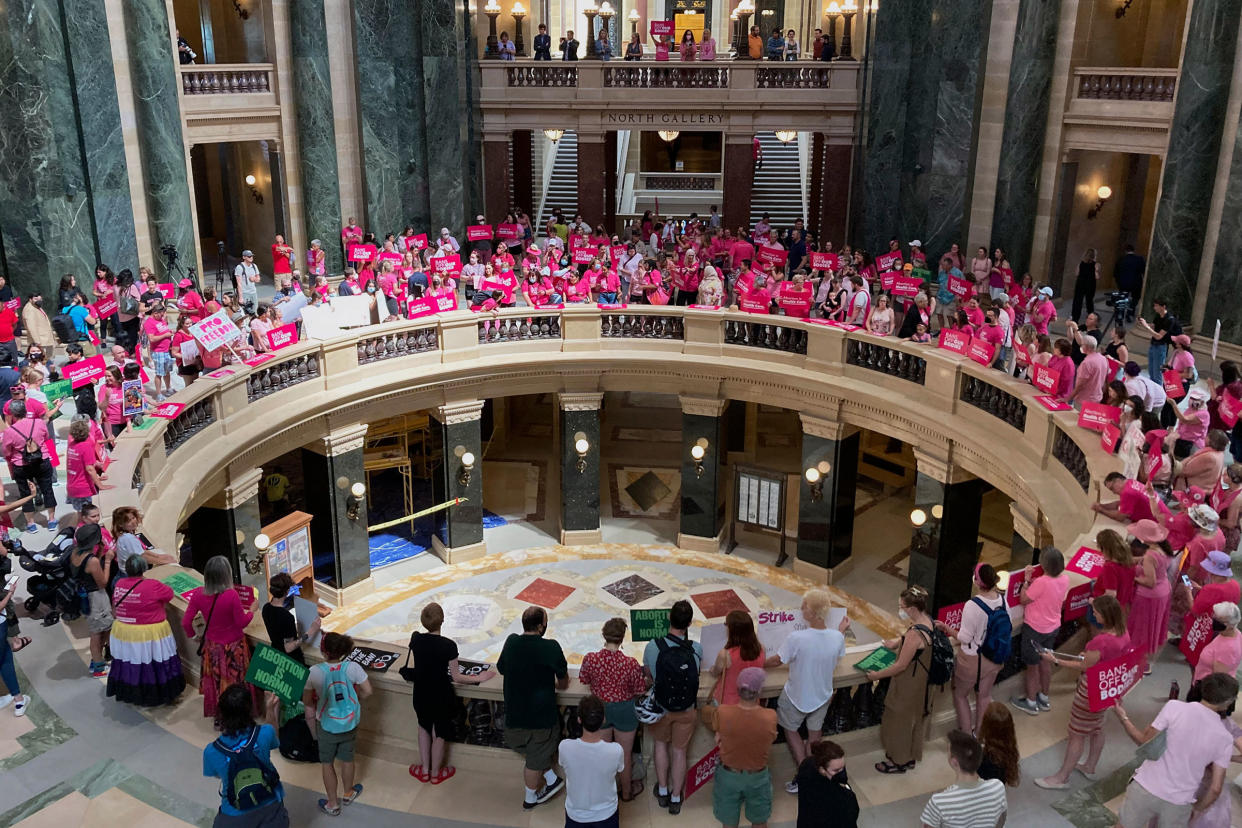What the Supreme Court’s Abortion Decision Means for Your State

Dozens of protesters gather in the Wisconsin state Capitol rotunda in Madison, Wis., on June 22, 2022, in hopes of convincing Republican lawmakers to repeal the state's 173-year-old ban on abortions. Credit - Todd Richmond—AP
After the Supreme Court’s decision in Dobbs v. Jackson Women’s Health Center, which overturned the constitutional right to an abortion, abortion rights will now largely be left up to states.
That means access to the procedure—and restrictions on it—are about to change even more dramatically depending on where you live. At least 23 states are likely to ban abortion in some form, according to a TIME analysis of data from the Guttmacher Institute, a research firm that supports reproductive rights, while 16 states and Washington D.C. will protect abortion rights. The others are in limbo: some states will likely call special sessions of their state legislatures to determine access, others could see access restricted after the midterm elections later this year.
Here’s a breakdown of what abortion access could look like in many states.
States with highly restricted abortion access
13 states have “trigger bans” that were designed to implement total or near total bans on abortion as soon as Roe was overturned.
Bans in Kentucky, Louisiana, and South Dakota appear set to take effect immediately. In Idaho, Tennessee, and Texas, the new laws will go into effect in 30 days.
Restrictive abortion laws in Arkansas, Mississippi, Missouri, North Dakota, Oklahoma, Utah, and Wyoming require state attorneys general, governors, or other officials to take action to put the bans in effect.
Oklahoma and Texas began testing the limits of restricting abortion before Roe v. Wade was overturned. Oklahoma passed the most restrictive abortion law in the country in May, which prohibits nearly all abortions with few exceptions. Texas enacted a law last fall banning abortions after about six weeks. Both states also have trigger bans in place that would now make performing an abortion a felony.
States strengthening abortion access
After a draft of the Supreme Court opinion was leaked in early May, California, Connecticut, Delaware, Hawaii, Maryland, New Jersey, New York, Oregon, and Washington got to work strengthening abortion access to prepare for the final decision.
These states will not only continue to provide abortion services, but have also bolstered various laws requiring insurance providers to cover abortion costs, expanded who is legally qualified to provide abortions, or altered extradition statutes to protect abortion providers and patients who travel from states where abortion is banned from being extradited and prosecuted.
States with limited abortion access
Iowa, Ohio, South Carolina, and Georgia all had six-week abortion bans that were previously blocked by courts for violating Roe v. Wade. Now, each state will likely look to quickly reinstate those laws.
Earlier this year, Arizona and Florida both enacted 15-week bans that were already set to go into effect later this summer. The state legislatures could now potentially pass stricter abortion bans.
Read More: New Abortion Clinics Are Opening Near Borders and Airports to Stretch Access as Far as It Will Go
Michigan and and West Virginia both passed laws that would criminalize abortions after 15 weeks before the Supreme Court made its decision. Both of those laws were challenged in court and are currently being litigated.
Alabama will likely chose between reinstating a pre-Roe abortion ban or resolving litigation against a 2019 law banning nearly all abortions. Iowa’s supreme court just ruled that abortions are not protected by the state constitution, paving the way for state lawmakers to ban abortion.
Wisconsin has a dormant abortion ban that was voided by Roe v. Wade; now it could take effect again. (Wisconsin’s attorney general has said he will not enforce the ban, but local prosecutors could look to do so.)
States where access will remain the same
Individuals in Colorado, Illinois, Maine, Massachusetts, Nevada, Rhode Island, Vermont, and Washington D.C. can expect to see no change in abortion access. Several of these states have passed laws enshrining abortion as a right and protecting individuals who seek or provide abortions. Minnesota and New Mexico will likely see abortion remain legal, though the states do not explicitly protect the right.

